Dr Paul Lam
Tai Chi for Arthritis is an ideal program designed for people with arthritis. Studies have shown it to relieve pain and improve quality of life.
How Tai
Chi Helps Arthritis?
? copyrights Dr Paul Lam, photocopy for educational purpose is permitted.
Synopsis
Exercise is an essential part of many approaches to better health and control of arthritic conditions. Most medical experts agree that suitable exercises for arthritis should aim at improving flexibility, muscular strengthen and fitness.
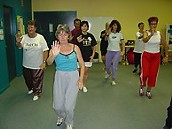
These additional benefits includes: promoting correct body posture; integrating body, mind and spirit; improving Qi (a life energy which governs all function of the body, essential for health and vitality); enjoyed by many; easy and inexpensive to learn and suitable for anyone.
There are numerous types of Tai Chi, a specially designed program for people with arthritis has many advantages.
What is Tai Chi?
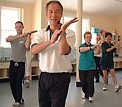
It consists of fluid, gentle and graceful circular movements, relaxed and slow in tempo. Breathing is deepened and slowed, aiding visual and mental concentration, relaxing the body and allowing the life force or ‘Qi’ to flow unimpeded throughout the body. These techniques help to integrate the mind and body and allow the achievement of total harmony of the body and mind.
Tai Chi can be practised at almost anywhere and is suitable for anyone because its level of exertion can be adjusted to suit each person’s physical condition.
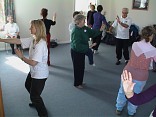
Exercise for Arthritis
There is irrefutable evidence that exercise benefits for most aspects of health. Exercise is an essential part of therapeutic approach for arthritis. Pain and stiffness of the joints tend to discourage patients from exercising. However without exercise, joints can become even more stiff and painful. This happens because exercise actually keeps bones, muscles, and joints healthy.
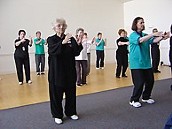
Studies after studies have shown the right exercises to relieve pain and improve quality of life for people with arthritis.(References: 1)
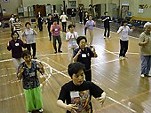
What Are the Suitable Exercises?
Most medical experts agree that suitable exercises for arthritis should aim at improving flexibility, muscular strengthen and fitness. Tai Chi not only does these; it also offers many other advantages:
1. Flexibility Exercises

Tai Chi gently moves all joints, muscle and tendons throughout the body. Studies
have shown Tai Chi significantly increase flexibility . (References
2; Reference 3; Reference 4)
Doctors from University of Florida (References: 5) divided
46 patients, who suffer from rheumatoid arthritis, evenly into two groups of
23. One group undertook exercises that were derived from Tai Chi and others
act as control. The exercised group showed greater upper extremity range of
motion after completing the program.
Atlanta
FICSIT Group (References: 6) conducted
an exciting study with a total of 200 participants (162 women and 38 men). The
results indicated that Tai Chi intervention impacted favourably on flexibility,
strength and cardiovascular endurance, as well as a massive 47.5% decrease upon
the occurrence of falls.
2. Muscle Strengthening Exercises
These exercises help maintain or increase muscle strength. Strong muscles help
keep the joints stable, therefore protecting the joints. This will minimise
future injury, reduce pain as improve muscle strength enables you to do more.

3. Fitness Exercises
Fitness or cardiorespiratory exercises help strengthen the heart and lungs and increases stamina, which is important for maintaining health. Arthritic joint and tissues need a good supply of blood and oxygen for healing. Better circulation of blood, fluid and oxygen also helps to keep joints flexible and muscles strong.
Tai Chi is a particularly effective fitness exercise. A interesting study (References: 12) involves 126 patients following acute myocardial infarct (heart attack). They were randomly assigned to Tai Chi, aerobic exercise and a non-exercise support groups. The people from Tai Chi group gain better cardiovascular fitness and lower blood pressure.

Many doctors believe correct body posture is important. When the posture is correct, there will be less inappropriate wear of the joints and muscles. When your posture is upright, the lung space is larger (try to take a big breath and straighten your chest, you will notice there is more space in the chest). The body works better in an upright posture.
A stooped body and drooping shoulders often associate with sadness, fear and negative emotion. Try to assume such a posture and you will most likely start having negative feelings.
More Reasons of Tai Chi Being Effective
There are more reason why Tai Chi help arthritis.
The Power of the Mind
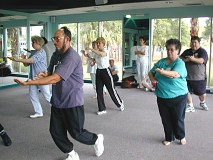
A recent review done by doctors from Stanford University (References: 13) on complementary and alternative treatments concludes that Mind-body techniques were found to be efficacious primarily as complementary and sometimes as stand-alone alternative treatments.
Clearly the immense power of the mind has not been fully estimated. As one of the most powerful mind-body exercise, Tai Chi teaches the student to be mindful of the intrinsic energy from which he or she can perceive greater self-control and empowerment.
Medical studies have found that Tai Chi improves the mental state for people with arthritis (References: 8); (References: 14); (References: 15); (References: 16); (References: 17)
The Power of Qi
Qi is the life energy inside a person. This life energy comes from the combination of three things: the air breathed in through the lungs, essential Qi from the kidney and the Qi absorbed from food and water through the digestive system. Qi circulates throughout the body, performing many functions to maintain good health. The stronger Qi you have, the healthier and stronger you are.
The concept of Qi is a basic belief in most eastern cultures for thousands of years, acupuncture and Chinese medicine base their central theory on this concept. The gentle and slow movements of Tai Chi opens up one’s energy channels and keep them strong and supple; the rhythmic movements of the muscle, spine and joints pump energy through the whole body. Tai Chi is one of the most effective exercises for Qi cultivation.
According to Chinese medicine, arthritis is caused by weak and sluggish flow of Qi. This is why for centuries Chinese doctors recommend Tai Chi for people with arthritis.
The Practical Advantages

It is a progressive exercise in the sense that no matter at what age you start Tai Chi, you can continue to improve your skill. The more one progresses the more intriguing and effecitve it becomes, Tai Chi has great depth like peeling an onion. There is a layer inside another layer. This is why people enjoy practising Tai Chi.
For an exercise to benefit people, it has to be interesting and pleasurable. If no one likes to do a particular exercise, it becomes useless no matter how effective it is. Follow up studies have found many people have difficulties adhering to their exercises. As Tai Chi teachers for many years we know many people enjoy practising Tai Chi and continue to come back year after year.
Tai Chi for Arthritis – the Program
Dr. Paul Lam, a family physician in Sydney, Australia, took up Tai Chi many years ago to reduce the impact of arthritis in his life. He became a proficient practitioner and teacher in different styles of Tai Chi. In 1997, Dr Lam realised the need to develop a Tai Chi program specifically for people with arthritis with the following objectives in mind: –
1. To provide a safe
and easy to learn program.
2. To relieve pain, stiffness and other problems associated with arthritis.
3. To improve relaxation and health.
In the year of 2003, this program has helped tens fo thousands of people with arthritis improve their pain and lifestyle. It is supported and adapted by Arthritis Foundations (including USA, UK and Australia) worldwide and is the subject of several clinical studies.
Why the Tai Chi for Arthritis Progam?

What Are the Characteristics of This Program?
It is based on the Sun style, one of the 4 major Tai Chi styles. Sun’s is particularly effective for arthritis because it is characterised by:
- Agile steps: whenever
you step forward or backward with one foot the other foot follows. This improves
mobility, essential for people with arthritis.
- Many Qigong exercises to improve relaxation and facilitate healing.
- Higher stances make it easier for people to learn.
- Having much depth of the art to hold learners’ interest as they progress.
It is short in duration and benefits almost all aspects of health making it ideal for busy people to improve health and lifestyle.
Click here for studies which have shown this program to relieve pain and improve ability.
How to Learn the Program?
You can learn this program
from the instructional
video, the book “Overcoming
Arthritis” and classes. Dr Lam and his
authorized master trainers conduct instructor’s
workshops worldwide.
REFERENCES:
1. Marian A. Minor: Physical Activity and Management of Arthritis. The Society of Behaviour Medicine Volume 13, number3 1991, 117-124. This review analyse many scientific papers.
Nordemar R, Ekblom B, Zachrisson L, Lundqvist K: Physical training in Rheumatoid arthritis, a controlled long-term study. Scand J Rheumatol 1981;10:17-23.
Ekblom B, Lovgren O, Alderin M, Fridstrom M, Satterstrom L: Effect of short-term physical training on patients with rheumaticd arthritis, study 1. Scand J Rheumatol 1975;4:80-86.
2. Lan-C; Lai-JS; Wong-MK; Yu-ML:Cardiorespiratory function,
flexibility, and body composition among geriatric Tai Chi Chuan practitioners.
Arch-Phys-Med-Rehabil. 1996 Jun; 77(6): 612-6.
3. Lan-C; Lai-JS; Wong-MK; Yu-ML: 12-month Tai Chi training
in the elderly: its effect on health fitness. Med-Sci-Sports-Exerc. 1998 Mar;
30(3): 345-51.
4. Chen,-W.-William; Sun,-Wei-Yue: Tai Chi Chuan, an alternative
form of exercise for health promotion and disease prevention for older adults
in the community. International-Quarterly-of-Community-Health-Education. 1997;
Vol 16(4): 333-339.
5. Van-Deusen-J; Harlowe-D: The efficacy of the ROM Dance Program
for adults with rheumatoid arthritis. Am-J-Occup-Ther. 1987 Feb; 41(2): 90-5.
6. Atlanta FICSIT Group: Reducing frailty and falls in older
persons: an investigation of Tai Chi and computerized balance training. J-Am-Geriatr-Soc.
1996 May; 44(5): 489-97.
7. Wolfson-L; Whipple-R; Derby-C; Judge-J; King-M; Amerman-P;
Schmidt-J; Smyers-D: Balance and strength training in older adults: intervention
gains and Tai Chi maintenance. J-Am-Geriatr-Soc. 1996 May; 44(5): 498-506.
8. La-Forge-R: Mind-body fitness: encouraging prospects for
primary and secondary prevention. J-Cardiovasc-Nurs. 1997 Apr; 11(3): 53-65.
9. Jacobson-BH; Chen-HC; Cashel-C; Guerrero-L: The effect of
T’ai Chi Chuan training on balance, kinesthetic sense, and strength. Percept-Mot-Skills.
1997 Feb; 84(1): 27-33.
10. Judge-JO; Lindsey-C; Underwood-M; Winsemius-D: Balance
improvements in older women: effects of exercise training. Phys-Ther. 1993 Apr;
73(4): 254-62; discussion 263-5.
11. Wolfson-L; Whipple-R; Judge-J; Amerman-P; Derby-C; King-M:
Training balance and strength in the elderly to improve function. J-Am-Geriatr-Soc.
1993 Mar; 41(3): 341-3.
12. Channer-KS; Barrow-D; Barrow-R; Osborne-M; Ives-G: Changes
in haemodynamic parameters following Tai Chi Chuan and aerobic exercise in patients
recovering from acute myocardial infarction. Postgrad-Med-J. 1996 Jun; 72(848):
349-51.
13. Luskin-FM; Newell-KA; Griffith-M; Holmes-M; Telles-S; Marvasti-FF; Pelletier-KR; Haskell-WL: A review of mind-body therapies in the treatment of cardiovascular disease. Part 1: Implications for the elderly. Altern-Ther-Health-Med. 1998 May; 4(3): 46-61.
14. Kutner-NG; Barnhart-H; Wolf-SL; McNeely-E; Xu-T: Self-report
benefits of Tai Chi practice by older adults.
AU: J-Gerontol-B-Psychol-Sci-Soc-Sci. 1997 Sep; 52(5): P242-6.
15. Jin-P : Changes in heart rate, noradrenaline, cortisol and mood during Tai Chi. J-Psychosom-Res. 1989; 33(2): 197-206.
16. Brown-DR; Wang-Y; Ward-A; Ebbeling-CB; Fortlage-L; Puleo-E; Benson-H; Rippe-JM: Chronic psychological effects of exercise and exercise plus cognitive strategies. Med-Sci-Sports-Exerc. 1995 May; 27(5): 765-75.
17. Jin-P: Efficacy of Tai Chi, brisk walking, meditation,
and reading in reducing mental and emotional stress. J-Psychosom-Res. 1992 May;
36(4): 361-70.
